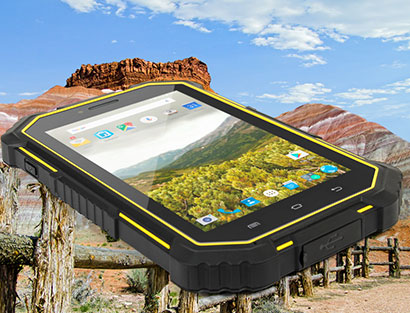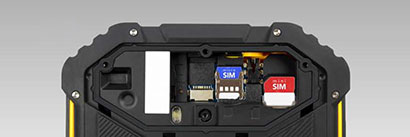The 7-inch Cedar CT7G rugged Android tablet was made available late 2016 from Juniper Systems as a technologically updated successor to the earlier Cedar CT7.

The Cedar product line was launched by Juniper Systems to meet customer demand for a lower cost, ruggedized Android line that would serve as a more suitable alternative to fragile consumer devices for outdoor applications. One that was built from the ground up for ruggedness, supports the cell bands used in the United States (including 4G LTE), has a proper IMEI (International Mobile Equipment Identity) number for security, and one that has, of course, passed all the requisite FCC & CE compliance testing.
The Cedar CT7G is a 7-inch class tablet running Android 6.0 (Marshmallow) on a quad-core ARM processor. The display offers 1280 x 800 pixel (216 ppi) resolution, the same as an Apple retina iMac 5k and plenty enough for a sharp picture. Like all modern Android tablets, the CT7G has capacitive multi-touch for the same intuitive, effortless user interface experience as consumer tablets. The LCD uses IPS (In Plane Switching) technology for a superior image and perfect viewing angles for all directions.
Being a ruggedized device with prominent corner protection, the CT7G is a bit larger than consumer 7-inch tablets but not by much. With a footprint of 8.5 x 5.4 inches, the Cedar tablet is still considerably smaller than an iPad, and for a rugged device it's also remarkably thin, just 0.75 inches. And with a weight of just 1.28 pounds, the CT7G is lighter than its predecessor and also considerably lighter than the original iPad.
For tech specs, the Cedar CT7G uses a 1.3GHz quad-core 64-bit Cortex-A53 MediaTek MTK6735 "WorldMode" 4G LTE platform also includes ARM Mali-T720 graphics. "WorldMode" refers to seamless roaming across high-speed 4G LTE networks and merging 2G, 3G and 4G technologies by supporting FDD/TDD (frequency-division and time-division duplex) LTE, WCDMA, CDMA2000, TDS-CDMA, EVDO, GSM, and EDGE.
There's two gigabyte of RAM and 16GB of Flash for storage, plus up to 32GB in the micro SDHC card slot. There is an 13mp documentation autofocus camera with LED flash on the backside, and a 2.0mp vidcam in the front. The unit's internal 26 watt-hour Li-Polymer battery should allow full-shift operation.
For wireless communication there's 802.11 b/g/n WiFi, Bluetooth 4.0, NFC, and integrated GNSS (GPS/GLONASS/Beidou), as well as 2G, 3G and 4G LTE cellular radio. Wired communication includes a micro-USB port and a 3.5mm audio jack.
Since the CT7G will be used by many geomatics industry and geospatial technology customers, the unit comes with a full gamut of internal sensors, including a G-sensor, distance/light sensing, a 3-axis gyroscope, an e-Compass, and geomagnetic sensing.
As far as overall design and construction go, the CT7G housing consists of an orange and a black plastic half with protective black overmolding. The two halves are held together by about a dozen screws and sealed via an o-ring around the entire perimeter. The dual SIM card (one nano-SIM and one mini-SIM) and micro SD card slots are user-accessible and located on top of the unit. The audio jack and the micro-USB port are at the bottom. The internal Li-Polymer battery can be replaced, but the unit needs to be opened in order to do so.
For controls, the CT7G tablet has the power switch on its left side, volume up and down on its right side and the three standard Android control buttons (Menu, Home, Back) beneath the display. There's a handstrap mount in the back of the unit that, with the strap installed, makes for easy one-hand carrying.

The Cedar CT7G certainly looks rugged, and the company refers to it as a "go-to product for field data collection." For now, though, the official specs don't include hard ruggedness data beyond a 3-foot drop spec and an IP68 rating, which means that it's totally dustproof and also protected against full and extended immersion in water. The manufacturer usually states how deep and for what duration, and that's not listed yet.
What's the price? We don't know yet. The predecessor CT7 cost US$899, about the same price as a premium consumer smartphone, and we expect the CT7G to come in at about the same price. Juniper's goal with the new CT7G is not to compete with ultra-rugged units such as their own Windows 10-based onto concrete, Mesa 2. Rather, in line with their stated mission of meeting customer demand for a lower cost, ruggedized Android line that would serve as a more suitable alternative to fragile consumer devices for outdoor applications, the aim here is to provide competent tablet hardware for the field that won't break the bank.






